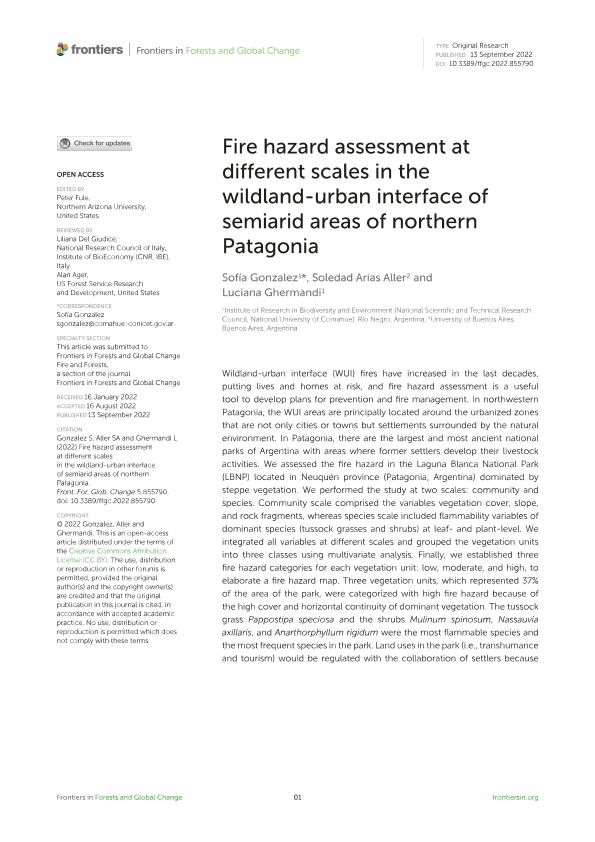Artículo
Fire hazard assessment at different scales in the wildland-urban interface of semiarid areas of northern Patagonia
Fecha de publicación:
09/2022
Editorial:
Frontiers Media
Revista:
Frontiers in Forests and Global Change
e-ISSN:
2624-893X
Idioma:
Inglés
Tipo de recurso:
Artículo publicado
Clasificación temática:
Resumen
Wildland-urban interface (WUI) fires have increased in the last decades, putting lives and homes at risk, and fire hazard assessment is a useful tool to develop plans for prevention and fire management. In northwestern Patagonia, the WUI areas are principally located around the urbanized zones that are not only cities or towns but settlements surrounded by the natural environment. In Patagonia, there are the largest and most ancient national parks of Argentina with areas where former settlers develop their livestock activities. We assessed the fire hazard in the Laguna Blanca National Park (LBNP) located in Neuquén province (Patagonia, Argentina) dominated by steppe vegetation. We performed the study at two scales: community and species. Community scale comprised the variables vegetation cover, slope, and rock fragments, whereas species scale included flammability variables of dominant species (tussock grasses and shrubs) at leaf- and plant-level. We integrated all variables at different scales and grouped the vegetation units into three classes using multivariate analysis. Finally, we established three fire hazard categories for each vegetation unit: low, moderate, and high, to elaborate a fire hazard map. Three vegetation units, which represented 37% of the area of the park, were categorized with high fire hazard because of the high cover and horizontal continuity of dominant vegetation. The tussock grass Pappostipa speciosa and the shrubs Mulinum spinosum, Nassauvia axillaris, and Anarthorphyllum rigidum were the most flammable species and the most frequent species in the park. Land uses in the park (i.e., transhumance and tourism) would be regulated with the collaboration of settlers because increase the vulnerability to wildfires. Our fire hazard map constitutes a valuable tool because it identified the most vulnerable WUI in the LBNP. This study emphasizes the need to include flammability and fuel load studies in fire management plans to better protect human lives and natural resources in protected areas.
Archivos asociados
Licencia
Identificadores
Colecciones
Articulos(INIBIOMA)
Articulos de INST. DE INVEST.EN BIODIVERSIDAD Y MEDIOAMBIENTE
Articulos de INST. DE INVEST.EN BIODIVERSIDAD Y MEDIOAMBIENTE
Citación
Gonzalez, Sofia Laura; Arias Aller, Soledad; Ghermandi, Luciana; Fire hazard assessment at different scales in the wildland-urban interface of semiarid areas of northern Patagonia; Frontiers Media; Frontiers in Forests and Global Change; 5; 9-2022; 1-14
Compartir
Altmétricas




